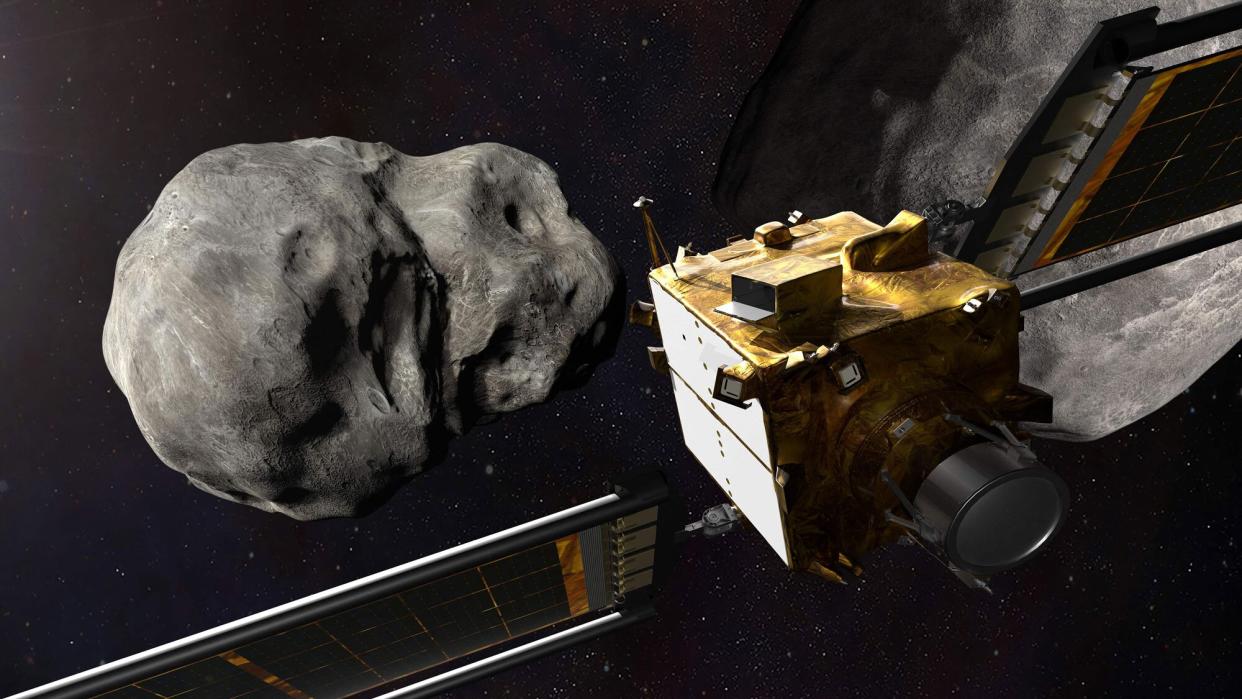NASA Crashing Spacecraft into Asteroid for First Planetary Defense Test: 'Stuff of Science-Fiction Books'

AFP PHOTO/NASA/Johns Hopkins APL/Getty
If all goes according to plan, NASA will be one step closer to preventing the plot of Netflix's Don't Look Up from ever happening in the future.
On Monday, the agency is set to test technology for defending the planet against potential asteroids and comets by crashing a spacecraft into an asteroid at around 14,000 mph.
But don't worry, the world's first-ever planetary defense test, NASA's Double Asteroid Redirection Test (DART), will be executed against a non-threatening asteroid, NASA shared in a release.
RELATED: 'Potentially Hazardous' Asteroid Twice the Size of Empire State Building to Fly by Earth
"This is stuff of science-fiction books and really corny episodes of 'StarTrek' from when I was a kid, and now it's real," said NASA program scientist Tom Statler, per the Associated Press.
Live: Join senior leaders from NASA and @JHUAPL working on the #DARTMission, the world's first test of planetary defense. Preview mission milestones between now and impact with a non-threatening asteroid on Sept. 26. https://t.co/Icq23Hb49a
— NASA (@NASA) September 22, 2022
The asteroid, called Dimorphos, is roughly 7 million miles away from Earth and 525 feet (160 meters) across, according to the AP. It orbits a parent asteroid Didymos and its potential re-routing is the center of $325 million planetary defense test.
The crash, scheduled for 7:14 p.m. EDT, is going to be monitored on cameras and telescopes, but it'll take days before scientists understand if the asteroid actually changed its course.
"This really is about asteroid deflection, not disruption," Nancy Chabot, a planetary scientist and mission team leader at Johns Hopkins University's Applied Physics Laboratory, told the news agency. "This isn't going to blow up the asteroid. It isn't going to put it into lots of pieces."
In 2022, our DART mission will test a new asteroid deflection technology. The target — a small moonlet posing no threat to Earth — is now named "Dimorphos," reflecting its status as the 1st celestial body to have the form of its orbit changed by humanity: https://t.co/DhPz9xjFZi pic.twitter.com/10WoWpzQwv
— NASA (@NASA) June 23, 2020
CBS News reports that there isn't an asteroid NASA knows to be larger than 140 meters (459 feet) that has "significant chance" of hitting Earth in the next 100 years, but it doesn't hurt to be safe. The collision itself is being looked at as monumental in the "history of humankind," per NASA planetary defense officer Lindley Johnson.
RELATED: Scientists May Have Found Pieces of the Asteroid That Caused the Extinction of the Dinosaurs: Report
"This demonstration is extremely important to our future here on the Earth and life on Earth," Johnson said, according to CBS News.
Never miss a story — sign up for PEOPLE's free daily newsletter to stay up to date on the best of what PEOPLE has to offer, from juicy celebrity news to compelling human interest stories.
The Johns Hopkins University's Applied Physics Laboratory is managing Dart, and the navigation of the spacecraft will reportedly be able to tell the smaller asteroid target from its larger sister asteroid before it makes impact. NASA says there's a less than 10% chance that Dart will miss its target, per the AP.
NASA will hold a 6 p.m. EDT briefing Monday, as well as a second at 8 p.m. after the impact.

